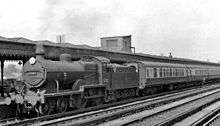SR L1 class
The Southern Railway L1 class was a class of 4-4-0 steam tender locomotives built for express passenger service on the South Eastern Main Line of the Southern Railway. They were designed by Richard Maunsell as a development of Harry Wainwright's L class.
| SR L1 class | |||||||||||||||||||||||||||||||||||||||||
|---|---|---|---|---|---|---|---|---|---|---|---|---|---|---|---|---|---|---|---|---|---|---|---|---|---|---|---|---|---|---|---|---|---|---|---|---|---|---|---|---|---|
.jpg) 757, circa 1928 | |||||||||||||||||||||||||||||||||||||||||
| |||||||||||||||||||||||||||||||||||||||||
| |||||||||||||||||||||||||||||||||||||||||
| |||||||||||||||||||||||||||||||||||||||||
| |||||||||||||||||||||||||||||||||||||||||
Background
Harry Wainwright had built two useful and attractive 4-4-0 classes for the South Eastern and Chatham Railway between 1902 and 1908; the D class and the E class, and had completed designs for a larger L class at the time of his retirement at the end of 1913. However, by 1918 they were beginning to struggle with the heaviest express trains. Wainwright's successor, Richard Maunsell, therefore rebuilt several examples of the D and E classes immediately before the grouping of the SECR with other railways to form the Southern Railway in 1923.
When Maunsell was appointed as Chief Mechanical Engineer of the new railway he turned his attention to designing new K & K1 class 2-6-4 tank engines. However, in 1926 there was an urgent requirement for fifteen more powerful 4-4-0 locomotives for the London to Folkestone express trains. Maunsell did not rebuild the L class as the locomotives were still relatively new and useful in their present form. He rather amended Wainwright's drawings to form his own L1 class, and supplied them to the North British Locomotive Company. The weight of the new class was increased to 57 tons 16 cwt. The boiler pressure was increased from 160 to 180 lbs per square inch but the cylinders reduced in diameter from 20 1⁄2 to 19 1⁄2 inches (521 to 495 mm). The engines also had long-travel piston valves, Maunsell’s own design of superheater and side-window cab and other detail alterations.[1]
Numbering
The locomotives were originally numbered A753–A759, and A782–A789, but were later renumbered by the Southern Railway as 1753–1759 and 1782–1789. All passed to British Railways (BR) in 1948 and were again renumbered between 31753 and 31789.
Operational details
The locomotives were used on express trains on the South Eastern main lines from London to Dover, Ramsgate, and Hastings. They remained on these duties until the mid-1930s when they were gradually replaced on the heavier trains by the newer ”King Arthur” and ”Schools” classes. They continued to be used on the former London Chatham and Dover Railway main line to Dover and Ramsgate until after the Second World War and the nationalisation of British Railways in 1948. The transfer of Bulleid “Light Pacifics” to these services in the early 1950s made the class largely redundant. Some were briefly transferred to Eastleigh and to replace worn out locomotives on cross-country services, but most spent their careers between London and the Kent coast. Withdrawal began in 1959. The final locomotive was withdrawn in February 1962. None remain.


References
- Bradley 1980, pp. 122–127.
- Bradley, D.L. (1980). The locomotive history of the South Eastern and Chatham Railway. London: Railway Correspondence and Travel Society. ISBN 0-901115-49-5.CS1 maint: ref=harv (link)